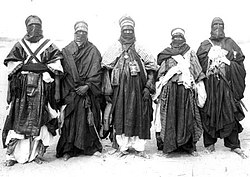User:Char/sandbox3: Difference between revisions
No edit summary |
No edit summary |
||
| Line 11: | Line 11: | ||
| region6 = {{flag|Mutul}} | | region6 = {{flag|Mutul}} | ||
| pop6 = 200,000 | | pop6 = 200,000 | ||
| region7 = {{flag| | | region7 = {{flag|Alanahr}} | ||
| pop7 = | | pop7 = 175,000 | ||
| region8 = {{flag| | | region8 = {{flag|Latium}} | ||
| pop8 = | | pop8 = 150,000 | ||
| langs = {{wp|Tamashek}} | | langs = {{wp|Tamashek}} | ||
| rels = [[Religion in Charnea|Kaharnic religions]] | | rels = [[Religion in Charnea|Kaharnic religions]] | ||
| Line 21: | Line 21: | ||
| native_name = ⴽⴻⵍ ⵜⴻⵏⴻⵔⴻ | | native_name = ⴽⴻⵍ ⵜⴻⵏⴻⵔⴻ | ||
}} | }} | ||
The '''Kel Tenere''' ({{wp|Tamashek}}: ⴽⴻⵍ ⵜⴻⵏⴻⵔⴻ), also known as the '''Tenerians''' or '''Imuhaɣ''', are a {{wp|nomad|nomadic}} {{wp|Amazigh people|Amaziɣ}} group indigenous to central [[Ajax#Scipia|Scipia]] and have historically inhabited parts of [[Messidor Union|Aɣmatia]], southern [[Tyreseia]], parts of [[Alanahr]] and the [[Charnea|Charnean Empire]]. In the modern day they are less widespread and are found primarily in Charnea as the native people of the [[Ninva|Tenere desert region]]. The term ''Kel Tenere'' translates to "People of the Desert" and is used by the Tenerians to differentiate themselves from the non-Amaziɣ ''Kel Eraahar'' or "People of the River", which encompasses the majority of the ethnic groups in modern day Charnea. In a more general context, the Tenerians refer to themselves as ''Imuhaɣ'' or "free people" , a term which relates them to their Amaziɣ cousins and distinguishes them from other desert dwelling non-Amaziɣ such as the {{wp|Arab people|Gharbaic}} {{wp|Bedouins}}. Today most of those who self identify as Kel Tenere are have become {{wp|urbanization|urbanized}} and transitioned to a modern sedentary lifestyle, while a small minority retain the ancestral nomadic way of life. However, most Tenerians observe a version of the nomadic Tenerian culture including traditional music, festivities, customs, [[Religion in Charnea|religion]] and other prominent features of the culture such as the martial art of [[Tebillant]] and a [[Gun culture in Charnea|gun culture]] rooted in nomadic practices. | The '''Kel Tenere''' ({{wp|Tamashek}}: ⴽⴻⵍ ⵜⴻⵏⴻⵔⴻ), also known as the '''Tenerians''' or '''Imuhaɣ''', are a {{wp|nomad|nomadic}} {{wp|Amazigh people|Amaziɣ}} group indigenous to central [[Ajax#Scipia|Scipia]] and have historically inhabited parts of [[Messidor Union|Aɣmatia]], southern [[Tyreseia]], parts of [[Alanahr]] and the [[Charnea|Charnean Empire]]. In the modern day they are less widespread and are found primarily in Charnea as the native people of the [[Ninva|Tenere desert region]]. The term ''Kel Tenere'' translates to "People of the Desert" and is used by the Tenerians to differentiate themselves from the non-Amaziɣ ''Kel Eraahar'' or "People of the River", which encompasses the majority of the ethnic groups in modern day Charnea. In a more general context, the Tenerians refer to themselves as ''Imuhaɣ'' or "free people" , a term which relates them to their Amaziɣ cousins and distinguishes them from other desert dwelling non-Amaziɣ such as the {{wp|Arab people|Gharbaic}} {{wp|Bedouins}}. Today most of those who self identify as Kel Tenere are have become {{wp|urbanization|urbanized}} and transitioned to a modern sedentary lifestyle, while a small minority retain the ancestral nomadic way of life. However, most Tenerians observe a version of the nomadic Tenerian culture including traditional music, festivities, customs, [[Religion in Charnea|religion]] and other prominent features of the culture such as the martial art of [[Tebillant]] and a [[Gun culture in Charnea|gun culture]] rooted in nomadic practices. The Kel Tenere united under a powerful chieftain [[Ihemod the Inheritor]], who went on to establish the Charnean Empire in the latter half of the 14th century. These events represented a deep upheaval of the Tenerian social fabric, breaking down a large part of the caste system and | ||
Revision as of 11:18, 28 October 2021
ⴽⴻⵍ ⵜⴻⵏⴻⵔⴻ | |
|---|---|
 Tenerian men in traditional desert dress. | |
| Total population | |
| 13,000,000 | |
| 9,000,000 | |
| 3,000,000 | |
| 450,000 | |
| 200,000 | |
| 175,000 | |
| 150,000 | |
| Languages | |
| Tamashek | |
| Religion | |
| Kaharnic religions | |
| Related ethnic groups | |
| Other Amaziɣs | |
The Kel Tenere (Tamashek: ⴽⴻⵍ ⵜⴻⵏⴻⵔⴻ), also known as the Tenerians or Imuhaɣ, are a nomadic Amaziɣ group indigenous to central Scipia and have historically inhabited parts of Aɣmatia, southern Tyreseia, parts of Alanahr and the Charnean Empire. In the modern day they are less widespread and are found primarily in Charnea as the native people of the Tenere desert region. The term Kel Tenere translates to "People of the Desert" and is used by the Tenerians to differentiate themselves from the non-Amaziɣ Kel Eraahar or "People of the River", which encompasses the majority of the ethnic groups in modern day Charnea. In a more general context, the Tenerians refer to themselves as Imuhaɣ or "free people" , a term which relates them to their Amaziɣ cousins and distinguishes them from other desert dwelling non-Amaziɣ such as the Gharbaic Bedouins. Today most of those who self identify as Kel Tenere are have become urbanized and transitioned to a modern sedentary lifestyle, while a small minority retain the ancestral nomadic way of life. However, most Tenerians observe a version of the nomadic Tenerian culture including traditional music, festivities, customs, religion and other prominent features of the culture such as the martial art of Tebillant and a gun culture rooted in nomadic practices. The Kel Tenere united under a powerful chieftain Ihemod the Inheritor, who went on to establish the Charnean Empire in the latter half of the 14th century. These events represented a deep upheaval of the Tenerian social fabric, breaking down a large part of the caste system and